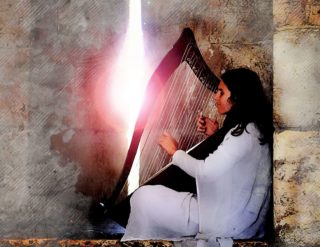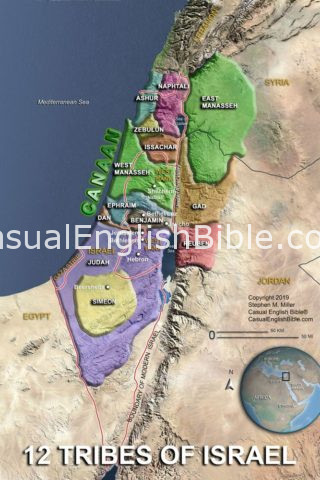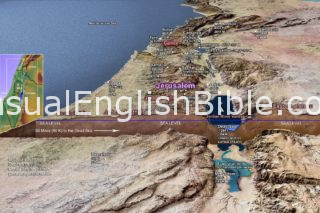
When Jews wanted a worship song to sing at the Jerusalem Temple, or alone at home, or on the road to Jerusalem, or at a celebration honoring the king, they could find one in this collection of 150 Hebrew poems.
These were poems written in lyrical style—fit to sing, chant, or think about while humming for those who couldn’t carry a tune.
There are songs:
- of joy and thankfulness to God.
- of complaint, about people, God, and life in general. The blues.
- of dismay, confusion, and disappointment. Fear, too.
- that tell about Jewish history
- celebrating the Jewish Law.
- of Wisdom, in the ancient style of Wisdom literature
Whatever the songs say, they say it as Hebrew poetry. It’s easy to recognize Hebrew poetry when we read it. Here’s the clue. One line says whatever it says, and the next either repeats that idea, contrasts it with an opposite idea, adds more to the idea, or in some other way builds on the bedrock of that first line.
For example:
“Be kind, LORD, because I’m sick.
Heal me, LORD, for I hurt all over” (6:2).
The second line says pretty much what the first line said.
Some English poetry is easy to spot because it rhymes. But as far as anyone has been able to tell, ancient Hebrew poetry didn’t rhyme at all. It did the rerun thing instead, working with parallel ideas compared, contrasted, or extended. Sometimes, to make the parallelism work, the writer uses different names for a place to avoid repeating the name. So, Jerusalem became Zion and Jacob (whose 12 sons produced extended families that became the 12 tribes of Israel) became Israel.
Knowing this can come in handy when we’re trying to figure out what to do with the lyrics the songwriter wrote. If it’s poetry, we might be less inclined to take the writer literally and more inclined to recognize the writer was driving with a poetic license.
Perhaps the most famous song of all is one we recite as someone approaches “the valley of the shadow of death,” Psalm 23. We remind ourselves that “the LORD is my shepherd.”
Jews call this songbook Tehilim, Hebrew for “songs of praise.” That’s half right.
Certainly there are a lot of praise songs in this 150-song playlist. But nearly half of the songs are complaints. People are calling on God for help because they’re sick, under attack, disappointed, or lonely.
You name the feeling, they sang it.
Some songs rip God a new face, expressing angry dissatisfaction with him:
“Why did you leave me… For all of my life, you have been my God” (22:1, 10).
Yet by song’s end, in most cases, the writer is back on good terms with God.
The lyrics often reflect life, telling the story of a faith journey with highs and lows, and of a God who is always there and always on the side of goodness.
Writer
King David gets what appears to be a byline for almost half the psalms, 73 of the 150. But that doesn’t mean he wrote them.
Subtitles that give the credit are vague: “A psalm of David.” The word “of” is the problem. It could mean he wrote it. But it could also mean someone merely wrote it about him or dedicated it to him.
Other Bible stories do confirm that Dave wrote songs and played music on a lyre, a harp that looks like it got wet and shrunk. When moody King Saul was feeling spooked and spooky, he called for David to come and play him some calming music on the lyre (1 Samuel 16:14-23). That usually settled his nerves.
David later wrote a song of mourning about the battlefield death of King Saul and Saul’s sons: “How have the mighty fallen!” (2 Samuel 1:19-27 New American Standard Bible.). An ancient Jewish scroll from about the time of Jesus, discovered among the famous Dead Sea Scrolls, reports that David wrote 3,600 songs.
Despite all the attention paid to David in the Book of Psalms, most scholars seem to agree that it’s unlikely that David personally wrote more than a handful of its 150 psalms. Other psalm writers probably included professional musicians associated with David and his successors. In addition, some of the laments (psalms that express complaints, dismay, confusion, or general misery) may have been written by individual worshipers, who left copies of their anguished prayers in the Temple, where musicians later adapted them for use in worship services.
What it all comes down to is that we really don’t know for sure who wrote any of the individual psalms.
Timeline
These songs are nearly impossible to date because they don’t usually tell a story with characters from history. They express timeless feelings, struggles, and hopes.
Some may have been written in David’s lifetime, some 3,000 years ago.
Some songs talk about life in Babylonian exile in what is now Iraq; and that happened 500 years after David, in the 500s BC.
Other songs go back to the time of Moses, some 200 to 400 years before David (scholars debate when Moses lived, 1200s BC or 1400s BC). But there’s no way to tell when those songs were written. They could have been written long after Moses by someone reflecting on Israel’s ancient history.
 Location
Location
Most psalms seem set in what is now Israel and Palestinian Territories, also called the Holy Land. Some are set in Egypt. Others talk about Jews in exile in ancient Babylon, which is now Iraq.
Intended readers
Jews used these songs to worship, much like Jews and Christians today use music to express their faith and their feelings.
Some songs were used in coronation rituals to crown a new king or to honor the anniversary of his reign.
Fifteen songs are called “songs of ascent” (Psalm 120-134). Jewish travelers sang these songs as they walked to Jerusalem to celebrate one of the religious holidays, such as Passover. The songs became known as songs of “ascent” because Jerusalem was in the Judean hills on top of a ridge next to the Mount of Olives ridge. No matter what direction travelers came from, they had to climb to reach Jerusalem.





